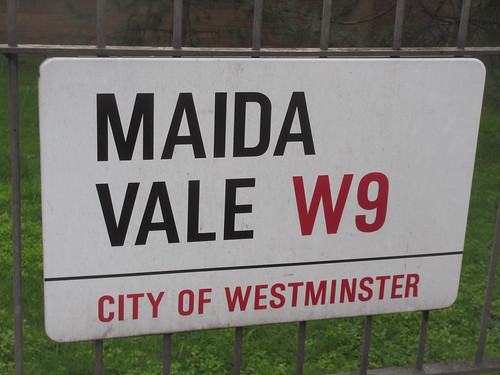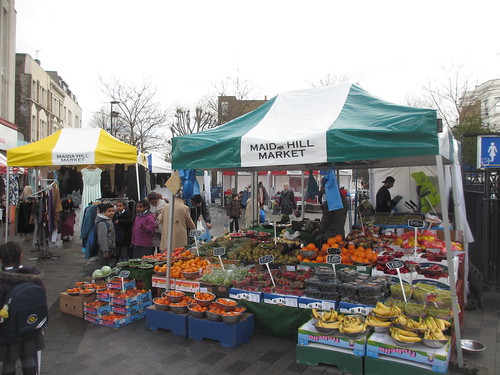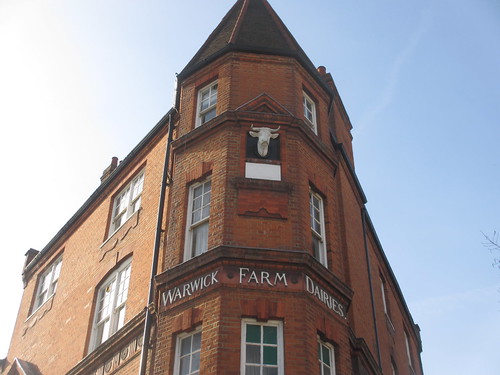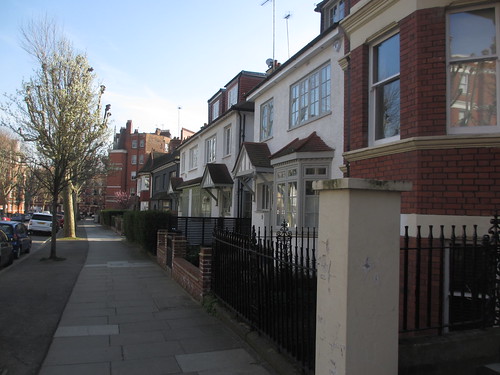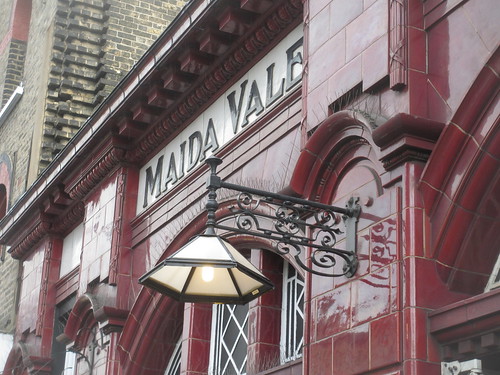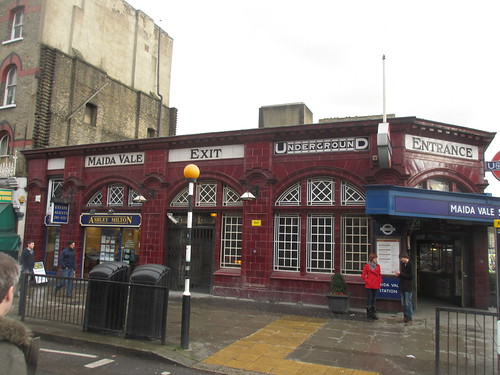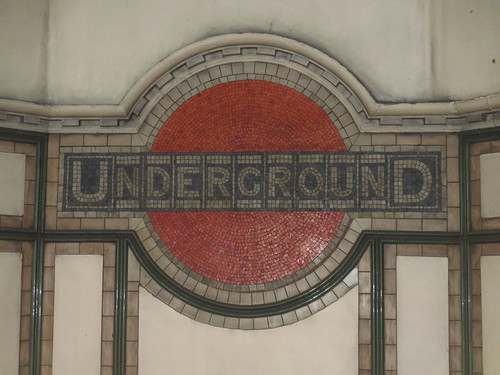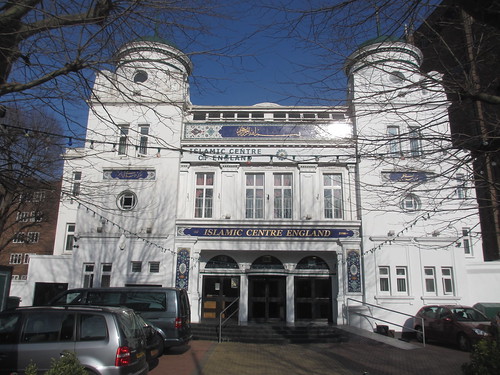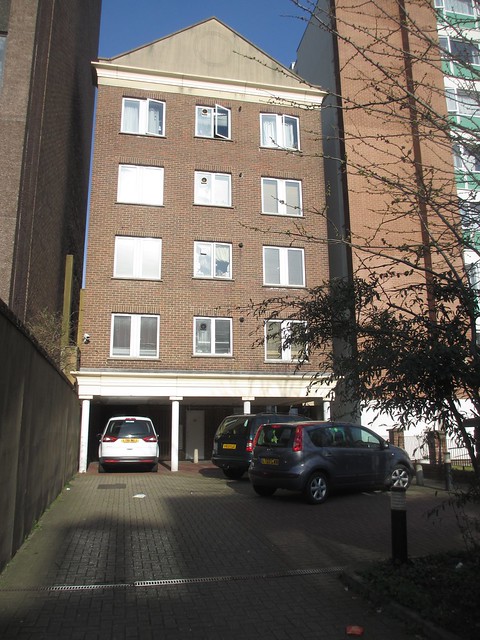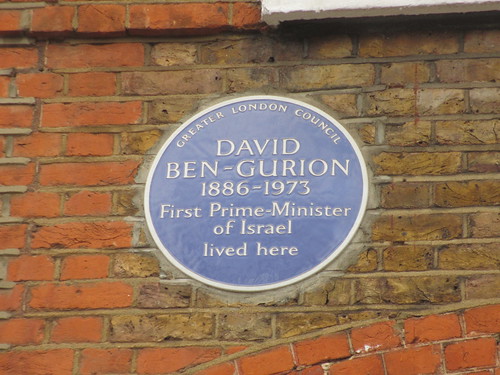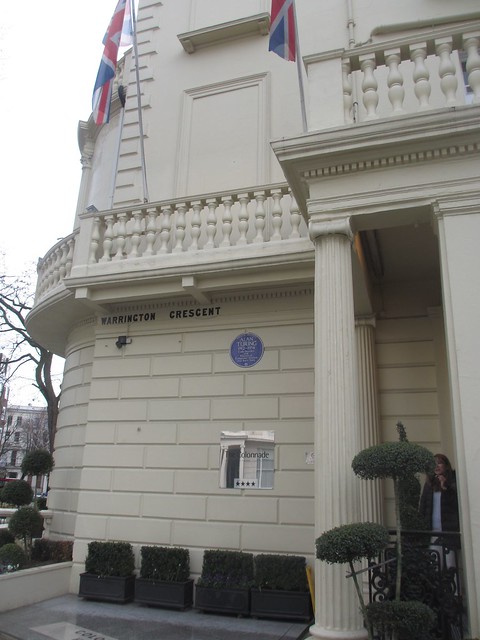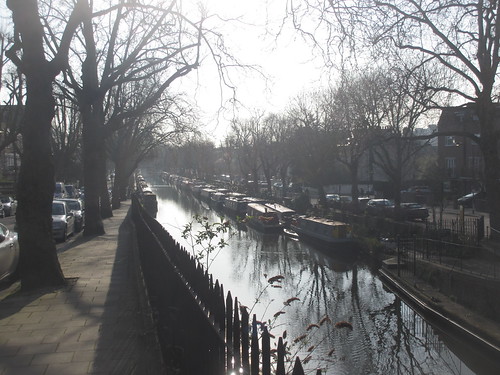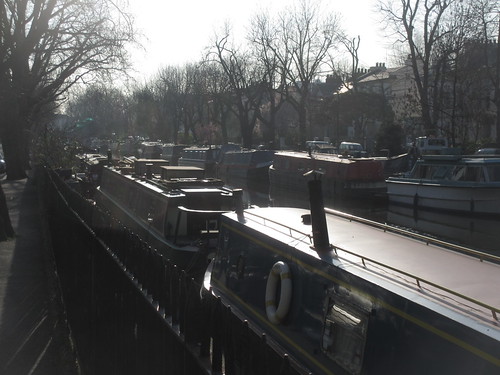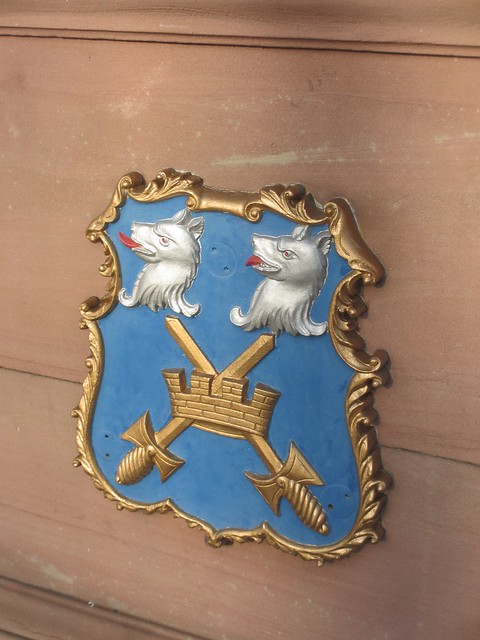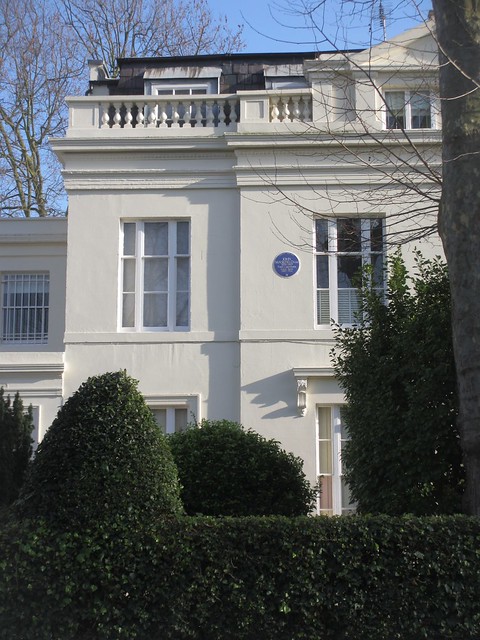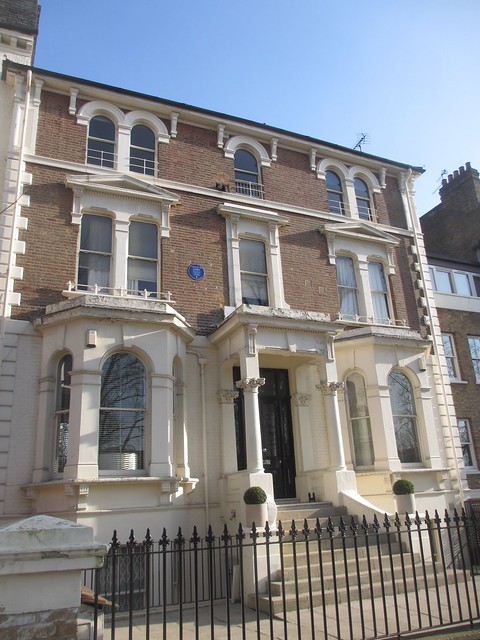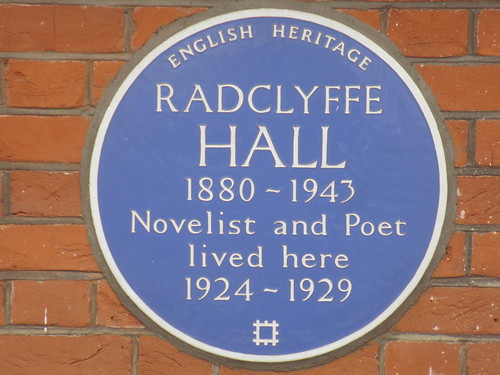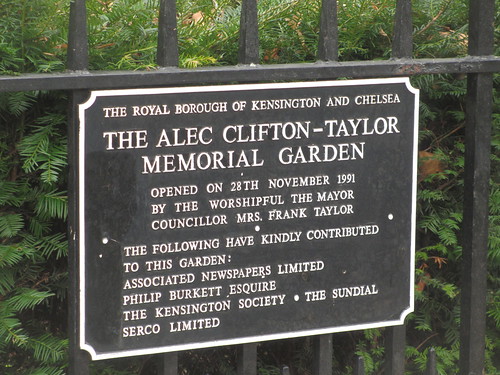W10 is North Kensington, not Kensal Green, I hear you say. And surely Kensal Green is in NW London. Well yes. But this is a quote from a poem which references not Kensal Green itself but Kensal Green Cemetery and that my friends is in W10 – as is the “Paradise” pub! But we are jumping ahead.
We start the W10 walk at the Ladbroke Grove Post Office at 116 Ladbroke Grove.
Turn right out of the Post Office and go under the railway bridge and then Westway. Take a right down the pedestrianised area which parallels Westway.
Stop 1: Under Westway and Portobello Green
All along here the whole area under the elevated road has been filled in with commercial development – offices, a gym, even a nightclub fittingly called “Flyover”. This development was completed in 1981 and is a great use of what otherwise be wasted space. Even the architectural guide, Pevsner (not exactly a fan of the 1970s and 1980s) says “It is a triumphant demonstration that once their functions are clearly defined, such difficult sites need not be disaster areas.”
And on the left of the path is a little garden, which I believe was created when Westway was built in the 1970s. A green oasis – but unfortunately not a quiet backwater given the horrendous traffic noise from Westway.
Continue walking and soon you will reach a white billowing tent – this is Portobello Green Market.
Stop 2: Portobello Green Market and Acklam Village Market
Portobello Green Market is a bit like an overgrown jumble sale with old clothes (sorry, vintage clothes), bric a brac and old magazines. No doubt there are some gems in here but you have to look as there is a load of old tat here too.
At the far side of Portobello Green Market from where you came in is Portobello Road itself – and there are usually some market stalls along the road side. When I was there, I saw one stall holder had a sense of fun having dressed up a couple of mannequins and put some familiar faces on top (well they are just about recognisable faces!)

Across the road is another type of market area. Being at the end of Acklam Road, this is called Acklam Market and runs Saturday and Sunday providing food, drink and music.

Walk up Portobello Road away from Westway (with Acklam Market on your right and Portobello Green on your left).
Stop 3: Portobello Road Arts Project
The Portobello Road Arts Project is a series of art commissions on a 100 metre stretch of wall which seeks to create a visual link between Portobello Road and Golborne Road. The idea is to encourage visitors to continue their journeys further up Portobello Road to discover Golborne Road, which is another market area.
The current installation is called “Aspects of Carnival” by Fiona Hawthorne which has 14 panels showing the vibrancy of North Kensington and celebrating Notting Hill Carnival. And it certainly does that.
“Aspects of Carnival” is the seventh in a series of original art installations here. The Royal Borough of Kensington and Chelsea is now seeking proposals for the next commission whose theme is “Heart of the Community”. The new work will be installed for six months, with a provisional launch date of 31 July 2014.
Continue walking along Portobello Road. The stalls thin out a bit and again you have to look hard for that little treasure amongst the dross. At Golborne Road turn right and continue through the market area and over the railway bridge.
Stop 4: Elkstone Road Sensory garden
After the railway bridge turn right into Elkstone Road and immediately on your right is our next stop – the Elkstone Road Sensory Garden. This is a nice little oasis, a garden where you can see, touch and smell. Unfortunately though it is right by the railway line so when a train goes through – and there are many – it is not as peaceful as it could be. So the one sense that is a bit bombarded is one’s hearing!
Just across the way you can see our next stop.
Stop 5: Trellick Tower
You may not have realised it but you will have seen the Trellick Tower as you crossed the railway bridge on Golborne Road. This distinctive tower was designed by Ernö Goldfinger (1902 – 1987). It is a 31 story tower containing 217 flats – completed in 1972. It has a long, thin profile, with a separate lift and service tower linked at every third storey to the access corridors in the main building; flats above and below the corridor levels have internal stairs. For many years it was regarded as a hideous eyesore but today it is recognised as a masterpiece of its kind and it is now Grade II* listed.
Fascinating “fact”: Ian Fleming is said to have named the James Bond villain Auric Goldfinger after Ernö. The story goes that Fleming had been among the objectors to the demolition of some cottages in Hampstead where Goldfinger built his house at 2 Willow Road (now National Trust and well worth a visit). When Goldfinger consulted his lawyers after publication of the book in 1959, Fleming threatened to rename the character “Goldprick”. Ernö decided not to sue. Apparently Fleming’s publishers agreed to pay his costs and gave Goldfinger six free copies of the book.
Retrace your steps along Golborne Road. After Portobello Road it becomes Chesterton Road. Continue along this until you reach Ladbroke Grove, where you should turn right.
Stop 6: Number 239 Ladbroke Grove
Our next stop is just at the first corner on the left (this is the corner of the first of three side streets confusingly called St Charles Square.)
The house here (number 239) was the home of Hablot Knight Browne (1815 – 1882) better known as Phiz, the illustrator of many Charles Dickens books.
Phiz’s relationship with Dickens started in the late 1830s when the first illustrator for Pickwick Papers (Robert Seymour) committed suicide having produced only 7 plates. A further two were produced by another illustrator and then Phiz took over. His first couple of plates were signed “Nemo” but then he changed his pseudonym. He is said to have explained that the change from “Nemo” to “Phiz” was made to harmonize better with Dickens’s “Boz.”
Phiz illustrated nine other Dickens books including David Copperfield, Dombey and Son, Martin Chuzzlewit and Bleak House. So many of those very familiar Dickensian characters were realised on the page by Phiz.
Continue walking along Ladbroke Grove and turn left at the third side street called St Charles Square. Go straight ahead and turn with the road as it becomes Exmoor Street.
Stop 7: St Charles Hospital
Our next stop is just on the left on Exmoor Street.
St Charles Hospital started life as St Marylebone Infirmary. It was opened by the then Prince and Princess of Wales in 1881. It became St. Charles’ Hospital when it was transferred from St. Marylebone Board of Guardians to the London County Council in 1930. It is an impressive yellow brick monster, which although amended over time has not acquired some of the awful inappropriate modern additions which get tacked on to such hospital buildings.
Today it provides a range of walk-in health services to the general public from 8am to 9pm, 7 days a week. There also seems to be a mental health unit here as well.
Continue to the end of Exmoor Street and turn right into Barlby Road. Go to the end and at the roundabout turn left and go over the railway bridge.
Here as you cross the railway, you can get another glimpse of the Trellick Tower.

Just over the railway bridge is our next stop, but to get the best view of it, keep walking and follow the entrance road into Sainsbury’s, going past the bus layby and looking back.
Stop 8: Kensal House
Kensal House is a residential estate built in 1937 and squeezed in between Ladbroke Grove, the Great Western main railway line and a gas works (now Sainsburys).
Kensal House designed by a team headed by architect Maxwell Fry. It was built for the local Gas Light and Coke Company to showcase the superiority of gas over electricity. The original flats were notable for their up to date gas cooking and heating equipment. It is now listed Grade II*.
Kensal House positioning on the site is clever and very forward thinking. It is designed on a North-South axis. Each flat has two balconies so as to catch the morning and evening sun.
Now you should be able to see our next stop ahead.
Stop 9: Ladbroke Grove Rail Crash memorial
This grey slab is the memorial to the Ladbroke Grove rail crash on 5 October 1999 in which 31 people were killed and more than 500 injured. A couple of years earlier (in September 1997) there had been another major accident on the Great Western Main Line a bit further west at Southall. Both crashes would have been prevented by an operational Automatic Train Protection system, but introduction of such systems had been rejected on cost grounds. These accidents severely dented public confidence in the management and regulation of safety of what was then the newly privatised railway system.
Lord Cullen chaired a public inquiry into the crash in 2000 which also covered the management and regulation of UK rail safety. The recommendations of the Cullen inquiry led to the creation of the Rail Safety and Standards Board in 2003 and of the Rail Accident Investigation Branch in 2005. The latter is independent of the Railway Inspectorate and so standard setting, accident investigation and regulation functions were clearly separated, on the model of the aviation industry.
Retrace your steps back to Ladbroke Grove and turn left.
Stop 10: Fruit Towers
Almost immediately ahead on the right at the corner of Kensal Road is a white building. Your eye is drawn to a window at the corner. It contains models of two deer with antlers – one bright blue, the other orange. This announces it is no ordinary building, look up and whilst there is no sign, there is a logo. This is Innocent and this my friends is what they call “Fruit Towers”.
Innocent was founded by three Cambridge University graduates. The story goes that in 1999, after spending six months working on smoothie recipes and £500 on fruit, the trio sold their drinks from a stall at a music festival in London. People were asked to put their empty bottles in a ‘yes’ or ‘no’ bin depending on whether they thought the three should quit their jobs to make smoothies. At the end of the festival the “Yes”‘ bin was full, with only three containers in the “No” bin, so they went to their work the next day and resigned. In total, it took fifteen months from the initial idea to getting a product to market.
But Innocent is not as innocent as you might think. In 2009, the Coca-Cola Company bought a minority stake said to have been between 10 -20%. In April 2010, Coca-Cola increased its stake in the company to 58% and then in February 2013 Coca-Cola increased their stake to over 90%, leaving the three founders with a small minority holding. But understandably Coca -Cola keep their connection discreet.
Continue walking along Ladbroke Grove and when you get to Harrow Road cross over and continue into Kilburn Lane.
Stop 11: Paradise by Way of Kensal Green pub, Kilburn Lane
Just a little way up on the left is a grand Victorian pub with the equally wonderful name “Paradise by way of Kensal Green”.


I had heard this phrase before and had kind of assumed it was John Betjeman. But no it is not. It was coined by G K Chesterton in his poem “The Rolling English Road” – first published under the title “A Song of Temperance Reform” in 1913. The full text of the poem is below:
The Rolling English Road
Before the Roman came to Rye or out to Severn strode,
The rolling English drunkard made the rolling English road.
A reeling road, a rolling road, that rambles round the shire,
And after him the parson ran, the sexton and the squire;
A merry road, a mazy road, and such as we did tread
The night we went to Birmingham by way of Beachy Head.
I knew no harm of Bonaparte and plenty of the Squire,
And for to fight the Frenchman I did not much desire;
But I did bash their baggonets because they came arrayed
To straighten out the crooked road an English drunkard made,
Where you and I went down the lane with ale-mugs in our hands,
The night we went to Glastonbury by way of Goodwin Sands.
His sins they were forgiven him; or why do flowers run
Behind him; and the hedges all strengthening in the sun?
The wild thing went from left to right and knew not which was which,
But the wild rose was above him when they found him in the ditch.
God pardon us, nor harden us; we did not see so clear
The night we went to Bannockburn by way of Brighton Pier.
My friends, we will not go again or ape an ancient rage,
Or stretch the folly of our youth to be the shame of age,
But walk with clearer eyes and ears this path that wandereth,
And see undrugged in evening light the decent inn of death;
For there is good news yet to hear and fine things to be seen,
Before we go to Paradise by way of Kensal Green.
Fascinatingly this poem was inspired by author’s strongly felt opposition to the idea of Prohibition into Britain. Chesterton saw it as an abuse of the ordinary man’s right to ordinary pleasures. So it is kind of fitting that there is a pub quite close to the cemetery which has been renamed “Paradise by Way of Kensal Green”.
It is a splendid building but obviously the Paradise … name is modern. A little bit of research reveals that this pub was originally called “Ye Old Plough” and this is borne out by the little relief on the side elevation.
Return to Harrow Road and there turn right. Just a little way along on the left is our final stop
Stop 12: Kensal Green Cemetery
This is one of the early commercial cemetery, dating from 1833 and it still appears to be privately owned and run. It was the first of the magnificent seven cemeteries – We have already seen Brompton in SW10 and no doubt we see the others on our travels.


Kensal Green Cemetery was inspired by the Père Lachaise Cemetery in Paris and has a wide variety of mausoleums and tombs, some of which are rather grand, as is the entrance arch.

It is a huge cemetery but we will focus on the eastern end as that is the bit that is I suppose in W10. The western entrance further up Harrow Road (where the Crematorium) is has a NW10 postcode.
So take a left as you go through the archway and head for the delightfully named “Dissenters’ Chapel”.
Just before you get there, there is a little plaque on the wall which commemorates Sir William Beatty. His main claim to fame is that he was the Ship’s Surgeon on board the HMS Victory and he witnessed Admiral Nelson’s death and subsequently wrote about it. Beatty claimed he did not administer treatment when Nelson was injured because he believed that the admiral was beyond treatment.
At his own request, Beatty was buried in an unmarked vault. This plaque is a memorial erected in the 1990s by the 1805 Club which is a society dedicated to maintaining the memory of the men of Trafalgar.
Now loop round in front of the Chapel. This by the way has an entrance on Ladbroke Grove which is not normally open – and this is one of the addresses used by the cemetery which confirms it is in W10.
Just a little way as you head back to the entrance you will see on your right a couple of columns side by side. These are not actually graves or tombs.
The one you come to first is the Robert Owen memorial. Robert Owen (1771 – 1858) was a Welsh born social reformer. He was involved amongst other things with New Lanark which was a Scottish mill town and housing – his wife being the daughter of the founder of the Mill. It is an early example of a planned settlement and important in the historical development of urban planning. New Lanark is one of five UNESCO World Heritage Sites in Scotland.
But he was actually buried in Newtown, Montgomeryshire so this just commemorates him. The monument itself has extensive praise for Owen:
“he originated and organised infant schools, he secured a reduction of the hours of labour for women and children in factories. He was a liberal supporter of the early efforts in favour of national education and laboured to promote international arbitration. He was one of the foremost englishmen (sic) who taught men to aspire to a higher social state by reconciling the interests of capital and labour. He spent his life and a large fortune in seeking to improve his fellow men by giving them education, self-reliance and more worth. His life was sanctified by human affection and lofty effort.”
The one next door is called The Reformers’ Memorial. Erected in 1885 at the instigation of man called Joseph Corfield who is also mentioned on the Owen monument. The Reformers’ Memorial is:
“to the memory of men and women who have generously given their time and means to improve the conditions and enlarge the happiness of all classes of society”. There are long lists of people who were considered reformers and radicals.
You can spent many an hour wandering through here, looking for the famous and not famous names (amongst the well known are both Marc and Isambard Kingdom Brunel, Wilkie Collins, William Makepeace Thackeray and Anthony Trollope). There are guided tours every Sunday from the Anglican Chapel (which is the one to the right as you came in).
Now for onward travel you can go out the gate you came in. You are on Harrow Road, near the junction with Ladbroke Grove and Kilburn Lane and there are a number of buses from here. The nearest station is actually Kensal Green which is a few minutes walk along Harrow Road left out of the cemetery gates.
So W10 has been fascinating. You do not really expect to find a poor bit of the Royal Borough of Kensington and Chelsea but this is it. It is sliced up by Westway, the Grand Union Canal and railways but still manages some interesting buildings, most notably two very different listed housing developments (Trellick Tower and Kensal House).





























